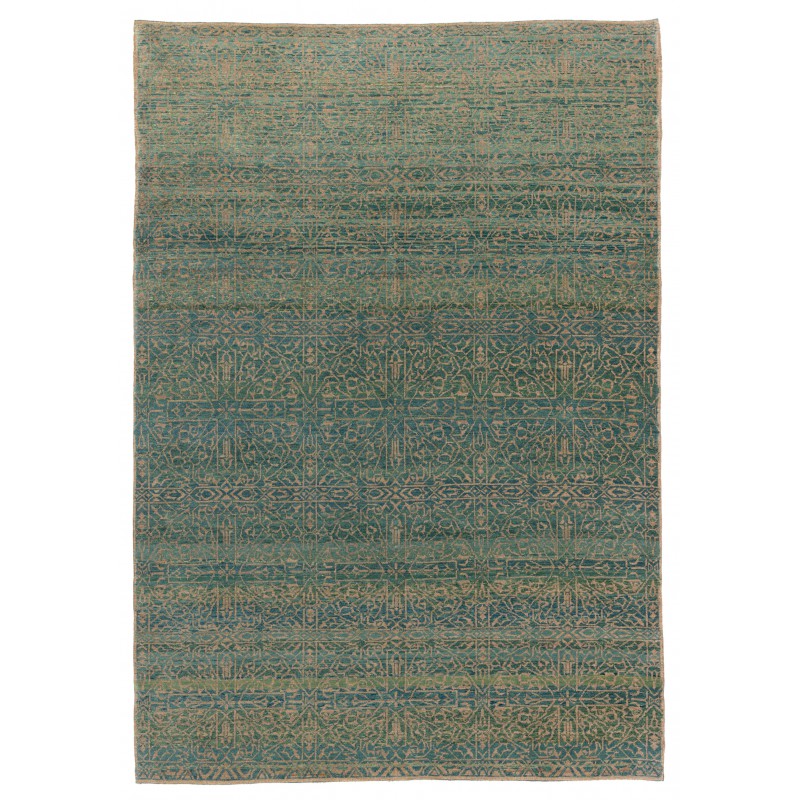
- Stock: In Stock
- Model: C50287
- サイズ: 224cm x 157cm
- Location: ISHITAYA
この絨毯は、マムルーク絨毯の一部から取られた幾何学的な格子模様で構成された解釈されたデザインを持ち、優雅にフィールドを埋め尽くしています。これは、15世紀のマムルーク時代、エジプトのカイロ地域でデザインされたより大きなスキームの一部である印象を与えます。マムルーク絨毯は、イスラム世界の多くの絨毯織り地域に共通する豊富な周縁放牧地と温暖な気候とは異なる物理環境で生まれました。これらの絨毯は、北のアナトリアを中心とする広範なトルコ織りの伝統に関連していますが、スタイライズされたパピルスの植物など、エジプトの伝統に深く根ざした非典型的な要素を含んでいます。彼らの異例の構成とレイアウトは、おそらく利益の上がるヨーロッパへの輸出市場で「マムルークブランド」を確立することができる特徴的な製品の開発を試みたものを表しています。また、イスラムの絨毯の世界ではほとんど唯一のものであるS-紡毛糸も特徴的です。エジプトで時計回りの毛糸の紡績の伝統が始まったのは、以前からエジプトで亜麻繊維を亜麻糸に紡ぐ伝統があったためとも言われています。植物の植物学的な構造の詳細は、羊毛や綿花の紡績に広く用いられるより一般的な反時計回りの方向で亜麻繊維を紡ぐことを不可能にしています。
シモネッティに見られる色の組み合わせを持つマムルーク絨毯は、現在ではアナトリア、イラン、シリアの織物と多くのつながりを持つ以前の伝統の一部として一般的に受け入れられています。メトロポリタン美術館のコレクションにもよく見られる「三色」のマムルーク絨毯は、1517年のエジプトのオスマン帝国による征服後も続いた後の発展を表しています。これらの絨毯の多くは、17世紀の終わりまで、おそらくそれ以上も生産されていた可能性があります。(ウォルター・B・デニー、エフティアール、ソウチェク、キャンビー、ハイダー、2011年)この絨毯のデザインは、弊社のマムルークタイプの絨毯コレクションからのデザイナーによって解釈され、柔らかな色が使用されています。
This rug has an interpreted design composed of a geometric lattice pattern taken from a part of the Mamluk rug, filling the field elegantly, has the impression that it is only part of a larger scheme designed 15th-century rug from the Mamluk era, Cairo region, Eygpt. Mamluk carpets originated in a physical environment that lacked the combination of abundant marginal grazing land and a temperate climate with cool winters that were common to most carpet-weaving areas in the Islamic world. While related to a broader tradition of Turkish weaving centered in Anatolia, far to the north, the designs of these carpets include atypical elements, such as stylized papyrus plants, that are deeply rooted in Egyptian tradition. Their unusual composition and layout probably represent an attempt to develop a distinctive product that could in effect establish a “Mamluk brand” in the lucrative European export market. The uncharacteristic color scheme—devoid of the undyed white pile and employing a limited range of three or five hues in much the same value—also suggests a conscious attempt to create a particular stylistic identity. Also virtually unique in the world of Islamic carpets is the S-spun wool. It has been argued that the tradition of clockwise wool spinning originated in Egypt because of the earlier Egyptian tradition of spinning flax into linen thread. Details of the plant’s botanical structure make it impossible to spin flax fiber in the more common counterclockwise direction utilized throughout the Middle East for wool and cotton.
Mamluk carpets with the color combinations seen in the Simonetti are now generally accepted as part of an earlier tradition that has many links to the weaving of Anatolia, Iran, and Syria. The “three-color” Mamluk carpets, well represented in the Metropolitan’s collection, represent a later development that continued well after the Ottoman conquest of Egypt in 1517. Many such carpets may have been produced well into the seventeenth century, and possibly even later. (Walter B. Denny in [Ekhtiar, Soucek, Canby, and Haidar 2011]). The design of the rug is interpreted by our designers from our Mamlouk-type rugs collection and soft colors are used for this rug.
全部で2色使っています。
- Bamboo Beige 99 (羊そのままの色)
- Feldgrau 414 (カモミール - 藍)
上の番号は私たちのカラーコードです。()の中は、主な草木染めの材料です。
